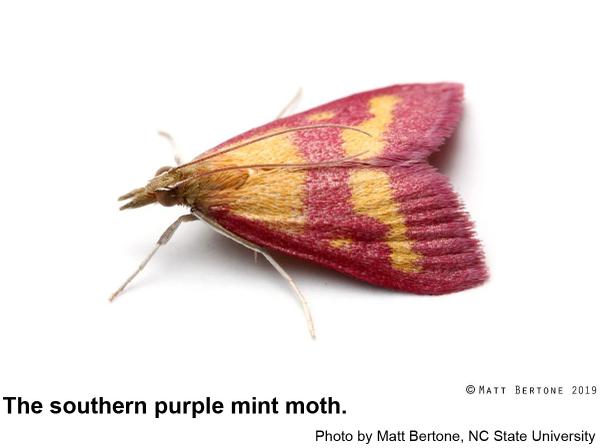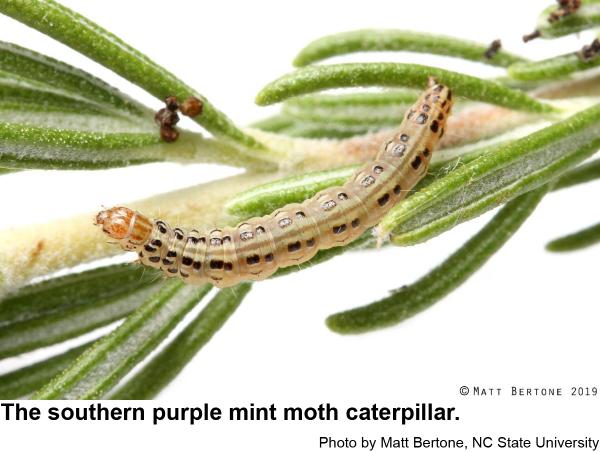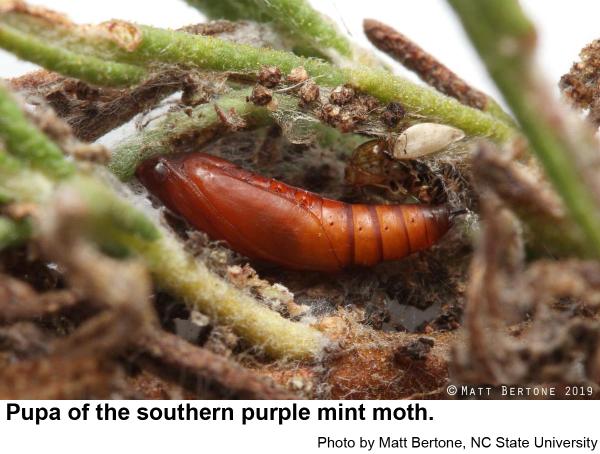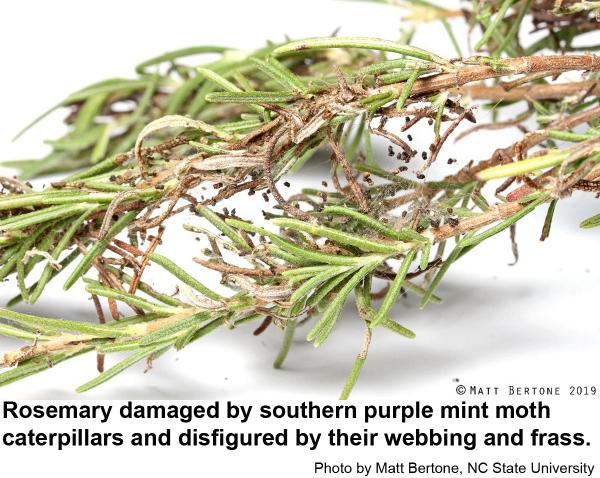Description and Biology
The southern purple mint moth, Pyrausta laticlavia, is a native species with a wingspan of 3/4 inch. It is a typical snout moth (the palps stick out in front) with reddish-purple wings marked with brownish-yellow bands. In some specimens the purple areas may be brown. Little has been published on the biology of this insect. Moths must lay eggs from which hatch tiny caterpillars. Older caterpillars are pale to green, are relatively slender and have rows of black spots down the back and sides. The caterpillars spin loose webbing as they feed. The webbing accumulates pellets of frass. Pupae are dark brown, slender, and taper at both ends. They are found in the silk webbing. These moths fly from June to August. We probably have several generations per year in North Carolina.
Host Plants
Caterpillars of the southern purple mint moth have only been reported feeding on rosemary, Rosmarinus officinalis. The mint-loving pyrausta moth, Pyrausta acrionalis, is a similar species that feeds on mints in the genus Mentha. It has deep rose to violet forewings with yellow borders along the leading edge and the fringes of the wing, as well as some mottled yellow markings.
Residential Recommendations
If growing rosemary for culinary use, it would be well to use insecticidal soap or insecticides with Bacillus thuringiensis as the active ingredient.
Other Resources
- Descriptions of American Lepidoptera, no. 1.Grote, A.R. and C.T. Robinson. 1867. Transactions of the American Entomological Society, 1: 1-34.
- Northward expansion of two mint-feeding species of Pyrausta in California (Lepidoptera: Pyraloidea: Crambidae). Powell, J. A. et al. 2000. Holarctic Lepidoptera 7 (2): 55-58.
- Species Pyrausta laticlavia - Southern Purple Mint Moth - Hodges#5070. Balaban, J. and J. Balaban. 2019 (update). Iowa State University Department of Entomology.
- Extension Plant Pathology Publications and Factsheets
- Horticultural Science Publications
- North Carolina Agricultural Chemicals Manual
For assistance with a specific problem, contact your local N.C. Cooperative Extension Center.
This Factsheet has not been peer reviewed.
Publication date: Nov. 4, 2019
Reviewed/Revised: Aug. 19, 2024
Recommendations for the use of agricultural chemicals are included in this publication as a convenience to the reader. The use of brand names and any mention or listing of commercial products or services in this publication does not imply endorsement by NC State University or N.C. A&T State University nor discrimination against similar products or services not mentioned. Individuals who use agricultural chemicals are responsible for ensuring that the intended use complies with current regulations and conforms to the product label. Be sure to obtain current information about usage regulations and examine a current product label before applying any chemical. For assistance, contact your local N.C. Cooperative Extension county center.
N.C. Cooperative Extension prohibits discrimination and harassment regardless of age, color, disability, family and marital status, gender identity, national origin, political beliefs, race, religion, sex (including pregnancy), sexual orientation and veteran status.





